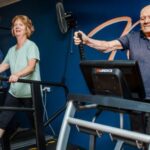Regular exercise is essential to effective pain management as it reduces pain severity and improves overall physical function. If you experience chronic pain, exercise will greatly enhance your quality of life. Though it may not be your instinct to combine exercise and chronic pain, we cannot recommend it enough.
How does exercise help with pain management?
First and foremost, exercise is just movement. Too many times people living with pain hear ‘exercise’ and cringe thinking they must run or lift heavy weights. Exercising – if you have not for a long time – or you have an injury or pain, doesn’t need to be scary. Small gentle movements that are reproducible, are the starting blocks and are essential to building tolerance to movement such as walking up stairs, lifting groceries out of the boot or hugging a loved one.
Exercise helps people, including those with chronic pain, experience a reduction in pain sensitivity called Exercise Induced Hypoalgesia (EIH). This pain management effect generally lasts for the duration of the exercise and for some time afterwards.
Unfortunately, not all people with chronic pain may be able to experience EIH, with their pain instead remaining the same or flaring up. As a result, they may choose not to engage in exercise. Many people who avoid exercise experience what’s known as deconditioning, where muscles weaken because they aren’t being used.
Deconditioning can worsen your pain and make your body less capable of daily tasks. Simple activities like walking and housework can become challenging. In fact, people who experience chronic pain are five times more likely to be limited in daily activities. Luckily, exercise prevents deconditioning and makes moving through life with chronic pain more manageable.
Exercising for pain management will also yield many other great benefits, including:
- Stronger, more flexible muscles.
- Reduced fatigue and increased energy.
- Improved sleep despite your pain.
- Decreased inflammation.
- Reduced stress.
To achieve the best pain management results from exercise, it’s best to engage the expertise of an exercise physiologist. A trained professional will know how to leverage EIH, why you may not experience EIH, and how to use exercise in the long term for an improved standard of living.
Types of exercise for pain management
There’s no one-size-fits-all solution when it comes to selecting the correct type of exercise for pain management. It’s best to incorporate a mixture of different exercises for optimal results. Consult your exercise physiologist first, and try the following:
- Aerobic exercises, like walking, running, swimming or cycling, that elevates your heart rate. You can modify these exercises to be lower impact; for example, swap running outside or on a treadmill for running on the elliptical machine.
- Resistance training, like weight lifting and pilates, that works your muscles under tension.
- Stretching, like yoga, tai chi and dynamic stretching, will also help improve mobility and avoid deconditioning.
The best exercises for you will always be the ones that you can maintain on a regular basis. You should find a location where you enjoy exercising, make sure you feel confident and comfortable in your workout gear, or get a gym buddy. These will all help you enjoy your exercise for pain management that little bit more.
Tips for exercising with pain
When exercising for pain management, having a plan of attack can be helpful. That doesn’t just mean knowing exactly what types of exercise you’ll be doing and how long for. It also means taking precautions to ensure you don’t push yourself too far, especially if you haven’t enlisted expert help. These precautions can look like:
- Modifying your exercises for peace of mind: When resistance training, you can set yourself up near a soft box or wall that can catch you if you unbalance. Likewise, running on an elliptical machine or cycling on a stationary bike require less balance and are a great choice if you’re concerned about falling.
- Ensure comfortable posture: Use a comfortable posture. Posture is different for everyone and there is not one perfect posture. The best posture is one you are comfortable in and can move around frequently to ensure that the muscles are not fatigued trying to hold one posture for too long.
- Use a range of motion that doesn’t increase pain: If you try an exercise and it’s not working for you, don’t force it. Readjust and use a range of motion that doesn’t worsen your pain, or make other accommodations, like adding extra support where you need it.
- Start low and go slow: It’s easy to get excited when people start throwing around sentences like “exercise is medicine”. Though this may be very true, you should start small on your pain management exercise journey. Finding your limits by immediately crossing them is a recipe for more pain and less pain management.
Remember, you know your body best. Challenging yourself outside your comfort zone is great, but listening to your body and setting boundaries is just as important. Too much exercise too soon can cause setbacks, like a flare-up, or may simply be unmanageable and demotivating.
Something is better than nothing, so there is nothing wrong in starting with 5-10 minutes of walking each day.
Getting started with exercise for pain management
There are many factors to account for when exercising with chronic pain. Considering them all and staying motivated on your pain management journey by yourself can be a challenge. We recommend seeking professional guidance from a trained exercise physiologist with expertise in exercise for pain management, like us.
Contact us today for more information on how we can work together!










